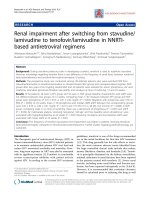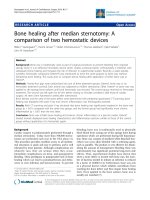Báo cáo y học: " Neurological prognostication after cardiac arrest" ppt
Bạn đang xem bản rút gọn của tài liệu. Xem và tải ngay bản đầy đủ của tài liệu tại đây (179.72 KB, 2 trang )
BioMed Central
Page 1 of 2
(page number not for citation purposes)
Scandinavian Journal of Trauma,
Resuscitation and Emergency Medicine
Open Access
Commentary
Neurological prognostication after cardiac arrest
Hans Friberg
Address: Department of Anesthesiology and Intensive Care, Lund University Hospital, Sweden
Email: Hans Friberg -
The care of the comatose cardiac arrest patient and his/her
relatives in the ICU constitutes a major challenge for
intensivists. Out-of-hospital cardiac arrest (OHCA) affects
more than 275.000 Europeans yearly; survival rates are
disturbingly low and have until recently remained
unchanged [1]. During the last several years, significant
efforts have been made to improve the quality of prehos-
pital care, with a focus on more effective chest compres-
sions. Postresuscitation care in the hospital was long ago
identified as the "missing link" in the chain of survival,
but a change in provision of care has occurred, as illus-
trated by the national Norwegian survey, published in the
Scandinavian Journal of Trauma, Resuscitation and Emer-
gency Medicine [2]. Three years have passed since the tel-
ephone survey, but 80% of the hospitals in Norway had
already introduced routine therapeutic hypothermia (TH)
at that time. Today, almost every emergency hospital in all
of Scandinavia routinely treats comatose cardiac arrest
patients of cardiac origin with TH, and many have imple-
mented a standardised treatment protocol as suggested
[3].
This novel, active treatment of cardiac arrest patients in
the ICU, as opposed to the former supportive approach,
has given the patients' relatives increased hope, presenting
new challenges to intensivists. The questions of when and
how to inform relatives of the prognosis of an individual
patient and of what prognostic tools should be used are
still under debate. An evidence-based review on the pre-
diction of outcome in comatose surviviors after cardiopul-
monary resuscitation was recently published, but it
remains unclear whether these results can be applied to
patients treated with hypothermia [4]. The survey by
Busch et al. [2] unsurprisingly shows that there is a great
deal of insecurity and even a lack of knowledge in the
medical community regarding prognostication after car-
diac arrest. The introduction of TH has changed the pre-
requisites for prognostication. The cooled patient is
sedated and intermittently paralysed during treatment,
and at the same time, the patient's metabolism is lowered
by approximately 30%, affecting drug turnover. Moreo-
ver, a lowered temperature over an extended period of
time may affect brain functions in an unpredictable way.
Many intensivists can testify to very late recoveries in indi-
vidual comatose, hypothermia-treated patients. However,
until we know more, great caution should be employed
when interpreting prognostic measures in these patients,
and, even more importantly, the timing of prognostica-
tion should be postponed. However, this necessary
change has not yet been reflected in clinical practise; a
majority of hospitals in the survey by Busch et al. perform
prognostication within 48 hours after hospital admission.
It is encouraging, though, that a multidisciplinary
approach was applied in prognostication in a large major-
ity of hospitals in the survey, involving intensivists,
internists and neurologists.
This analysis leads to the following statements. First, neu-
rological prognostication after cardiac arrest should rou-
tinely be performed as a joint task, preferably together
with a neurologist, and it should be carried out using a
standardised protocol. Second, prognostication must be
postponed in comatose cardiac arrest patients and should
be performed no earlier than 48–72 h after resumption of
normothermia. In addition, sedation should be with-
drawn prior to a decisive neurological examination. If in
doubt, a new evaluation should be performed daily, and,
if no improvement is seen after three days, termination of
active treatment should be considered. Third, a clinical
neurological examination is still the basis for prognostica-
Published: 15 September 2008
Scandinavian Journal of Trauma, Resuscitation and Emergency Medicine 2008, 16:10 doi:10.1186/1757-7241-16-10
Received: 25 August 2008
Accepted: 15 September 2008
This article is available from: />© 2008 Friberg; licensee BioMed Central Ltd.
This is an Open Access article distributed under the terms of the Creative Commons Attribution License ( />),
which permits unrestricted use, distribution, and reproduction in any medium, provided the original work is properly cited.
Publish with BioMed Central and every
scientist can read your work free of charge
"BioMed Central will be the most significant development for
disseminating the results of biomedical research in our lifetime."
Sir Paul Nurse, Cancer Research UK
Your research papers will be:
available free of charge to the entire biomedical community
peer reviewed and published immediately upon acceptance
cited in PubMed and archived on PubMed Central
yours — you keep the copyright
Submit your manuscript here:
/>BioMedcentral
Scandinavian Journal of Trauma, Resuscitation and Emergency Medicine 2008, 16:10 />Page 2 of 2
(page number not for citation purposes)
tion [4,5], on which 100% of Norwegian hospitals in the
present survey agree. Moreover, at least in our centre, a
decision to withdraw treatment may only be taken when
a neurological examination is corroborated by at least one
objective measure. Such measures include a pathological
electroencephalographic (EEG) pattern at normothermia
[6], a somatosensory evoked potential (SSEP) investiga-
tion with a bilateral lack of cortical response [7,8], and
high and increasing levels of the brain damage marker
neuronspecific enolase (NSE) at 24–48 h post arrest
[[8,9], own results, to be published]. Hence, a score on the
reaction level scale (RLS) of 7 or 8, corresponding to a
value of 3 or 4 on the Glasgow Coma Scale (GCS), in com-
bination with one or more objective parameters of severe
brain damage provides the basis for a decision to with-
draw treatment in our ICU. The difficulties and pitfalls of
prognostication after cardiac arrest, induced hypothermia
and more will be discussed at the upcoming 3
rd
Interna-
tional Hypothermia Symposium in Lund, Sweden, 2–5
Sept. 2009. Please find more information on our website
.
Finally, we agree with Busch et al. that international evi-
dence-based guidelines for the prognostication and fol-
low-up of hypothermia-treated cardiac arrest patients are
required. In fact, this work is now being incorporated into
the guidelines being established by the 2010 International
Liaison Committee on Resuscitation (ILCOR).
Competing interests
The author declares that they have no competing interests.
Acknowledgements
Lund University Hospital and Region Skåne, Sweden.
References
1. Herlitz J, Bang A, Gunnarsson J, Engdahl J, Karlson BW, Lindqvist J,
Waagstein L: Factors associated with survival to hospital dis-
charge among patients hospitalised alive after out of hospital
cardiac arrest: change in outcome over 20 years in the com-
munity of Goteborg, Sweden. Heart 2003, 89:25-30.
2. Busch M, Søreide E: Prognostication after out-of-hospital car-
diac arrest, a clinical practice survey. Scandinavian Journal of
Trauma, Resuscitation and Emergency Medicine 2008, 16:9.
3. Sunde K, Pytte M, Jacobsen D, Mangschau A, Jensen LP, Smedsrud C,
Draegni T, Steen PA: Implementation of a standardised treat-
ment protocol for post resuscitation care after out-of-hospi-
tal cardiac arrest. Resuscitation 2007, 73:29-39.
4. Wijdicks EF, Hijdra A, Young GB, Bassetti CL, Wiebe S: Quality
standards subcommittee of the American Academy of Neu-
rology. Neurology 2006, 67:203-10.
5. Booth CM, Boone RH, Tomlinson G, Detsky AS: Is this patient
dead, vegetative, or severely neurologically impared? JAMA
2004, 291:870-879.
6. Rundgren M, Rosén I, Friberg H: Amplitude-integrated EEG
(aEEG) predicts outcome after cardiac arrest and induced
hypothermia. Int Care Med 2006, 32:836-842.
7. Tiainen M, Kovala TT, Takkunen OS, Roine RO: Somatosensory
and brainstem auditory evoked potentials in cardiac arrest
patients treated with hypothermia. Crit Care Med 2005,
33:1736-1740.
8. Zandbergen EG, Hijdra A, Koelman JH, Hart AA, Vos PE, Verbeek
MM, deHaan RJ: PROPAC Study Group. Prediction of poor
outcome within the first 3 days of postanoxic coma. Neurology
2006, 66:62-68.
9. Tiainen M, Roine RO, Pettilä V, Takkunen O: Serum neuron-spe-
cific enolase and S-100B protein in cardiac arrest patients
treated with hypothermia. Stroke 2003, 34:28.









